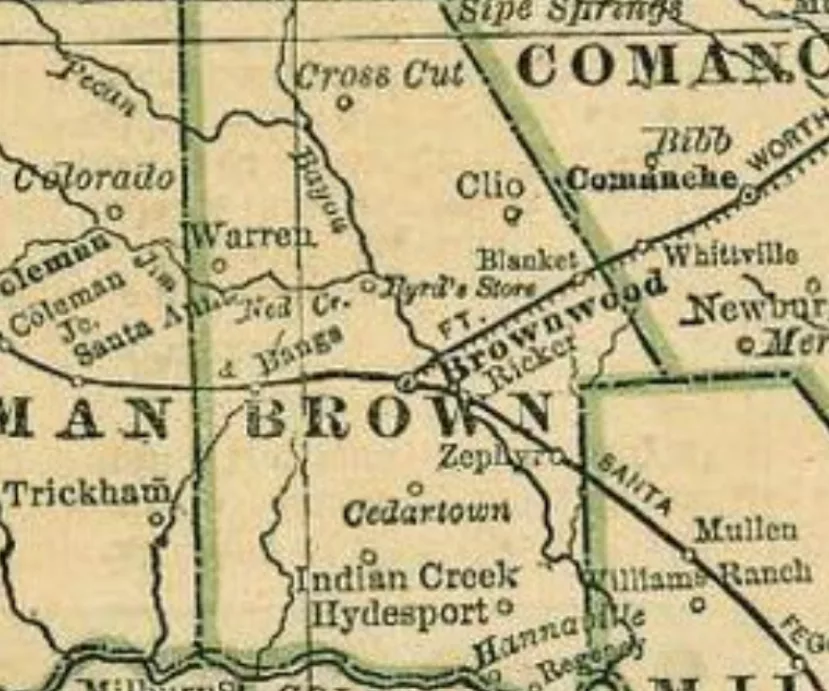
My grandpa was a mapmaker. I used to spend hours in his room, where he had maps spread out everywhere–maps of caves, the moon, railroad lines and topographic maps. I guess that is how I developed a love for looking at the things, especially old ones. A certain mystery is there, especially when you look at a place on a map that no longer exists. It makes you wonder what happened, why did some towns simply disappear, while others close by thrived and grew?
There is an older map of the Brownwood area that shows a now defunct town just south of Brownwood called Cedarton, sometimes Cedartown and also Cedar Point. Cedarton is one of those places that seems to have slipped out of history. There is no write-up about in any local history chronicle that I could find, no record of who lived there or how it got its name, except for a note that at one time Cedarton did have its own post office. An edition of the Galveston Daily News in August 1884 describes “A post office has been established at Cedarton, Brown county, on route 31,655, Brownwood, seven miles northeast, J. Bob, seven miles southwest.”
A deep dive into old newspapers and records produced some information that gives a few hints about Cedarton’s past. Published in an 1887 edition of The Standard, a weekly newspaper supporting the “Georgist perspective” out of New York, contains a short letter to the editor from a man by the name of Dotson. It says, “J. J. Dotson, Cedarton, Brown county Tex–The people hearabouts are in great distress, caused by the continued drought. A great many are in actual need of bread and clothing. This has set me a-thinking, and the land and labor movement, only just begun, is growing very fast. We are with you heart and hand in this great land reform.” I’m not sure what the political movement was that Dotson supported, but it doesn’t seem to have worked out for Cedarton. A check of the records at the Cedar Point Cemetery, Cedarton’s cemetery, does not show J. J., but does contain the grave of a Lucinda J. Dotson, who died in 1908. Perhaps she was the wife of J. J..
A further look through the Cedar Point Cemetery records shows that the Crudup family was integral in the formation of Cedarton. The website Brownwooodhistory.org states, “The Crudup family gave the land for the Cedar Point Cemetery. It appears the oldest dated grave marker is that of Mr. Drewery P. Crudup, with the date of October 12, 1876. Cedar Point was named for a large cedar tree on the old Drinkard place. The first school was built in 1877. It was a one room log cabin and had one teacher for all grade levels. The school continued in this building until 1915, when the building burned. Later the Cedar Point school consolidated with the Chapel Hill school in 1932.’
So the town of Cedarton was named for a big cedar tree. I have to admit I was hoping it was named after the infamous Hill County band of wild-living ‘cedar choppers’ that was active around the same time, but it was not to be. One thing is sure though, and something my grandpa taught me, when you put your finger down on an old map like the one above, there is bound to be something at any given spot worth knowing. I couldn’t discover if the desperate conditions in Cedarton that J. J. Dotson wrote about were resolved. Maybe the drought and its related suffering serve as a form of obituary for the town itself, a theme common to many small towns in Texas that no longer exist.
***
Diane Adams is a local journalist whose columns appear Thursdays on BrownwoodNews.com. Comments regarding her columns can be emailed to littleadams@gmail.com.
